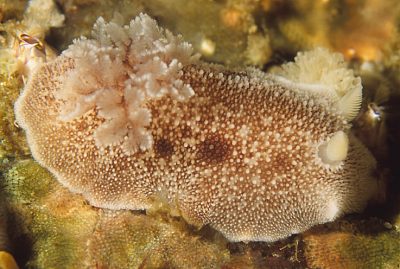Peltodoris marmorata from Chile
December 31, 2002
From: Marcelo Krause

Bill,
Here is a picture taken at Antofagasta region, North of Chile. The water temp was 12C and the depth was around 60ft.
Best regards,
Marcelo.
marcelo@underwater.com.br
Krause, M., 2002 (Dec 31) Peltodoris marmorata from Chile. [Message in] Sea Slug Forum. Australian Museum, Sydney. Available from http://www.seaslugforum.net/find/8719Thanks Marcelo,
I think this is a species called Peltodoris marmorata, and have asked a couple of experts [Michael Schroedl & Angel Valdes] who have worked on this fauna for their opinion. As you can see from their replies they are not in total agreement. One of the problems is that some of the earlier descriptions of species from South America were not very good. Often descriptions of new species were based on decolourised, poorly preserved specimens, and so we know very little about the external colour and shape, and even less about the internal anatomy. One of the basic rules of scientific nomenclature is that we should use the earliest available name. So we have to check all the old descriptions to see whether an animal has been named more than once. If so we have to use the earliest. The biggest problem with this is that we have to decide if the early descriptions in fact apply to the same species. Even if we can solve that problem, we then can have a second complication. Two different species cannot have the same name. What sometimes happens is that a species may be named in one genus, but later be shifted to another genus. If there is already a species in that genus with the same species name, one of the species has to change their names.
Peltodoris marmorata is a good example of this. It was originally described as Anisodoris marmorata Bergh, 1898. However, Marcus & Marcus (1967) decided that a quite different species that Bergh had described from the Mediterranean as Archidoris marmorata Bergh, 1881 was really a species of Anisodoris, so two species had the same name. As the South American species was named later, it needed a new name, which Marcus & Marcus gave it [Anisodoris rudberghi]. However, Valdes & Muniain (2002) have recently re-examined the anatomy of this species and consider it is better placed in the genus Peltodoris. Since there is no other species of Peltodoris called Peltodoris marmorata, then Marcus & Marcus's replacement name A. rudberghi is no longer necessary, and so we can revert to calling the species Peltodoris marmorata.
From Michael Schroedl's message it seems the debate may not be over on the identity and name of this species. He suggests he has seen caryophyllidia on the mantle of this species, which would mean it is not a species of Peltodoris. Valdes & Muniain specifically say it does not have caryophyllidia. Schroedl also suggests there is an earlier name for this species, Doris variolata d'Orbigny, 1837, while Valdes & Muniain consider that species to be so badly described that it is not possble to identify it. It is of course possible that Schroedl and Valdes & Muniain are discussing two different species. This unfortunately is a good example of how difficult it is sometimes to sort out nomenclatural problems. Many early species descriptions were very poor and we tend to spend more time sorting out ancient problems than we should. Unfortunately, taxonomy is the only science where you cannot ignore incompetent work. I am not of course referring to Schroedl, Valdes or Muniain, when I make that comment. They are just the poor unfortunates who are trying to sort out what may be an insoluble problem.
All I can do at this stage is suggest we use the name Peltodoris marmorata.
I look forward to some more South American photos,
Best wishes,
Bill Rudman
Related messages
-
Re: Peltodoris marmorata from Chile
From: Michael Schroedl , December 31, 2002 -
Re: Peltodoris marmorata from Chile
From: Angel Valdes, December 31, 2002
